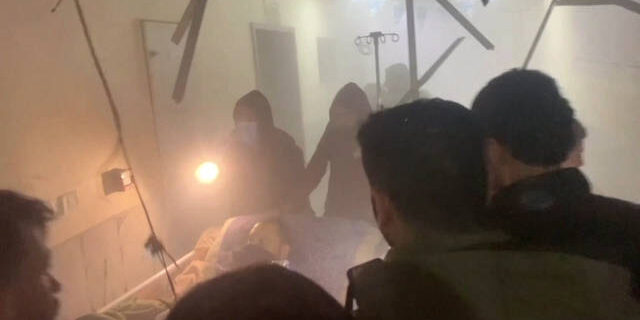“Gaza has become a death zone,” says World Health Organization Director-General Tedros Adhanom Ghebreyesus. As Israel’s assault on the besieged Palestinian territory continues into its fifth month, statistics fail to describe the horror inflicted on the 2.3 million Palestinians trapped there. Gaza’s hospitals have become battlegrounds themselves.
“I’ve been to over 40 different countries, doing humanitarian work, anywhere from Africa, Asia and South America. What I saw in Khan Younis were the most horrific scenes in my entire life, and I hope I never see them again,” said Dr. Yasser Khan, a Canadian ophthalmologist who recently returned from a humanitarian surgical mission at the European Hospital in Khan Younis in Gaza, on the Democracy Now! news hour.
“The bombings were going on every few hours…The Israeli forces were about a kilometre away. And the mass casualties kept on coming in.”
Dr. Khan continued:
“The majority of the patients that I treated were children, anywhere from the age of 2 to 17. I saw horrific eye and facial injuries that I’ve never seen before, eyes shattered in two, 6-year-old children with shrapnel that I had to take out, eyes with shrapnel stuck inside, facial injuries. I saw orthopaedic injuries — limbs just cut off and dangling. I saw abdominal injuries that were just horrific. It was just mass chaos. There were children on the floor, unattended to, with head trauma, people suturing patients without anaesthesia on the ground.”
Southern Gaza’s largest health facility, Nasser Hospital in Khan Younis, stopped functioning on Sunday, February 18, following a week-long Israeli military siege and raid.
Dr. Ahmed Moghrabi, Chief of Plastic Surgery at Nasser, sent Democracy Now! a video describing when Israeli troops stormed the hospital at 1:30 on Sunday morning:
“They bombed and shelled the third floor, they targeted the orthopaedic department…It was chaos, everybody running…they destroyed the back wall of the hospital and released their dogs. I ran away from the hospital with my family, with many patients….”
Videos Dr. Moghrabi shared show blood-covered patients being dragged on gurneys along hospital corridors through dust- and smoke-choked hallways lit only by flashlight.
Days later, after being blocked by the Israeli army for two days, a team from the WHO made it into Nasser Hospital. One team member, Chris Black, posted a video describing the scene, and their efforts to transport the most threatened patients:
“This hospital is the most important referral hospital south of Wadi Gaza. It’s now on its knees, the entire neighbourhood around here is damaged and destroyed. The hospital itself has no electricity, no food, has no water… We have four ambulances from the Palestinian Red Crescent Society. We can put two, maybe three patients at most in these ambulances. The road coming in here is very, very hard to manipulate. We’re going to be back here as long as it takes to make sure the patients that need more medical care can get to where they need to.”
The World Health Organization is one of a score of agencies and organizations that comprise the Inter-Agency Standing Committee, which coordinates global humanitarian aid. The committee issued a blistering statement on Wednesday, addressing the overall situation in Gaza. It read, in part:
“The health system continues to be systematically degraded, with catastrophic consequences. As of 19 February, only 12 out of 36 hospitals with inpatient capacity are still functioning, and only partially. There have been more than 370 attacks on health care in Gaza since 7 October. Diseases are rampant. Famine is looming. Water is at a trickle. Basic infrastructure has been decimated. Food production has come to a halt. Hospitals have turned into battlefields. One million children face daily traumas.”
Irfan Galaria is a plastic and reconstructive surgeon who volunteered in Gaza with the humanitarian aid group MedGlobal. He wrote an op-ed, published in the LA Times, with the chilling headline, “I’m an American doctor who went to Gaza. What I saw wasn’t war — it was annihilation.”
Speaking on Democracy Now!, Dr. Galaria described Israel’s “deliberate attempt to incapacitate the healthcare system. The healthcare system in Gaza has collapsed. Hospitals have been targeted. They no longer have the physical capacity or space to care for their patients. Physicians are being killed. Healthcare workers are being killed. They’re being targeted. They’re being imprisoned. There’s no medical aid or medical equipment that’s coming through.”
Dr. Galaria concluded, “I’ve been in war zones…I was not prepared for what I saw here.”
Targeting hospitals, as Israel is doing in Gaza with U.S. complicity, is a war crime. On Tuesday, a UN Security Council ceasefire resolution received a 13-1 vote. The U.S. was the sole ‘no’ vote, using its veto power to kill the resolution, allowing the mass killing in Gaza to continue.
This column originally appeared in Democracy Now!



